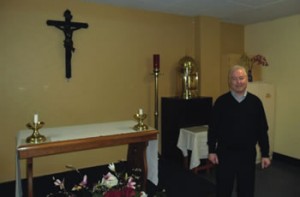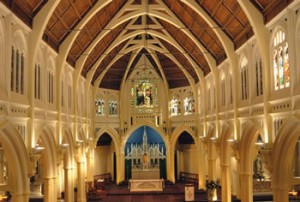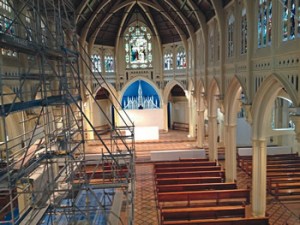Fr Barry Scannell sm – PP of St Mary of the Angels
MM: How have the parishioners coped with the closure of their church?
Fr Scannell: The parishioners have been overwhelmingly supportive. It’s inconvenient because they now have to go to four different venues for Mass on Sunday, and we have Mass in the hall during the week, but overwhelmingly they support our decision to strengthen the building to as close to 100% of the seismic strengthening code that we can actually achieve. We’ve been planning to strengthen the church for quite some time – since it was designated an earthquake-prone building by the Wellington City Council in 2008. When the earthquakes of 21 July happened – two of them during Mass – especially the 6.5 at 5.09 p.m., a substantial shake that caused parishioners in the church particular concern, (as it did for all Wellingtonians), we didn’t get any damage from the quake. But we really had to look hard at whether we would continue to use the building because we knew it was below 33% of the building code. Over the course of the next week or so we looked closely at our obligations both legally and morally and decided we were better to close the church and get on with the process of strengthening the building.
MM: Has the parish been able to continue providing its usual services?
Fr S: Our parish hall has been turned into a chapel which seats nearly a hundred people, so all weekday Masses are celebrated there; three Masses each day, and at 11 a.m. on Saturday. The Sunday 7 a.m. Mass is also celebrated in the new chapel. Reconciliation is provided at all the times we had previously, in the presbytery.
MM: How has the choir managed?
Fr S: Probably of all parishioners the choir has suffered the greatest disruption, because they can no longer practice in the choir room, in the crypt, and of course they can’t sing with the beautiful organ. We now have what was previously our 11 a.m. Sunday Gregorian Chant Mass at St John’s Presbyterian church at midday. And so the choir practices either in our parish hall or at St John’s. It has been a big challenge for them because they now have to take all their music and all they need for their practices to St John’s where there is a beautiful organ, of course, but like all the other parishioners they’ve been generous in their response to the situation and are still providing us with beautiful music.
For our Sunday services, 7 a.m. Mass is in the hall; 9 a.m. is in the Cathedral. The Cathedral staff and parishioners have been most generous, as has St Joseph’s parish, Mount Victoria, where we have our 5 p.m. Mass.
St John’s Presbyterian parish has been extraordinarily generous in letting us use their church, and that has happened before, in the 1990s when the inside of St Mary of the Angels was redecorated. The parishioners at St John’s have never forgotten that the first Catholic parish priest in Wellington, Fr O’Reily, back in 1845, celebrated their funerals while their minister was still back in Scotland. They still talk about that, and that’s one of the reasons why they are so generous and hospitable to us in our time of need. Their “One building, two congregations, total denomination” sign was up on their wall to greet us.
MM: What is happening in regard to strengthening the church against earthquakes?
Fr S: It’s a great challenge to strengthen a church like this because you want to retain the integrity of the building. And because it’s a Category One Historic Place you have to engage a heritage architect, and you have to have the blessing of the Historic Places Trust. We have been very careful to take those people along with us in the whole planning process, so at the moment, having closed the church, we have been able to x-ray and scan and investigate the integrity of the building in terms of its seismic strength, because, at the beginning, in 1920 to 1922 when this church was built, the use of concrete was in its infancy. As well, the builder walked off the job after a year and Fr Stanislaus Mahony completed the church with unskilled labour. So the steel and the concrete are not up to the kind of standard that is required nowadays. Having said that, it has to be acknowledged that it is still a very substantial building.
Building practices from that time have been superseded today; there’s a need to put reinforcing in the building that will bring it up to 100% of the building standard. The building meets only between 15 and 20% of the current code. The reassuring thing, and perhaps the reason that the building has performed so well over 90 years of life, is the fact that it is built on rock, and just the wonderful architectural nature of a Gothic church. While it’s done well over 90 years, we couldn’t guarantee it if we had a very big quake.
It is estimated that the church will be closed for 18 months.
MM: How much money is needed?
Fr S: The design drawings are expected to cost between three and four hundred thousand dollars. Repair work will cost several million dollars.
St Mary of the Angels is not only a significant centre of worship for Wellington Catholics and visitors to the capital; it’s a cultural centre too, but it’s more than that – we believe it’s the heart of Catholicism in central Wellington. Whenever there’s an event in Wellington many visitors who have been so used to coming here for Sunday Mass are sad not to be able to worship in the church on Sunday.
If you wish to make a donation to the St Mary of the Angels’ Parish Seismic Strengthening Account, the postal address is St Mary of the Angels, 17 Boulcott Street, Wellington 6011.
Bank account details for direct credit deposits: BNZ, Lambton Quay Branch, Wellington
Account # 02-0536-0003242-23
Donations are tax deductible.
Tagged as: Fr Barry Scannell, Mary, St Mary, St Mary of the Angels
Comments are closed.



 Entries(RSS)
Entries(RSS)